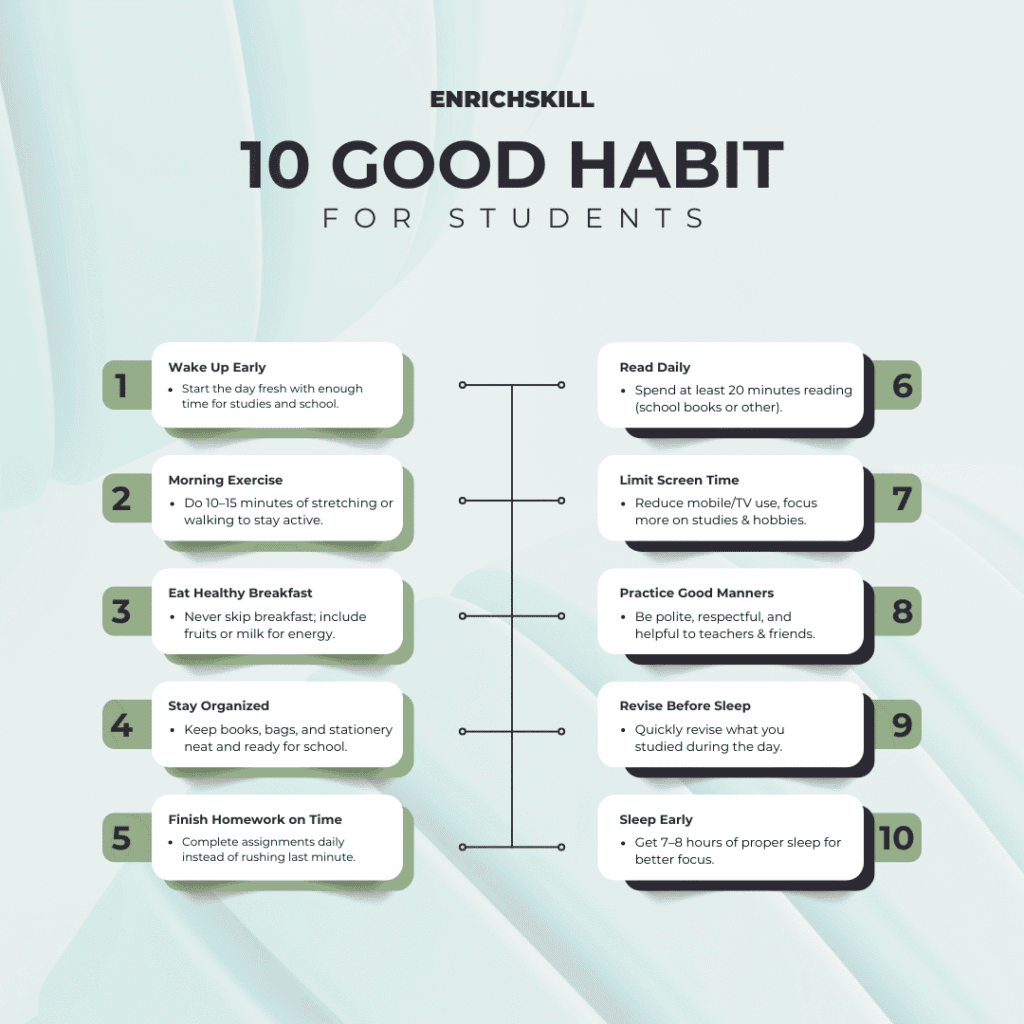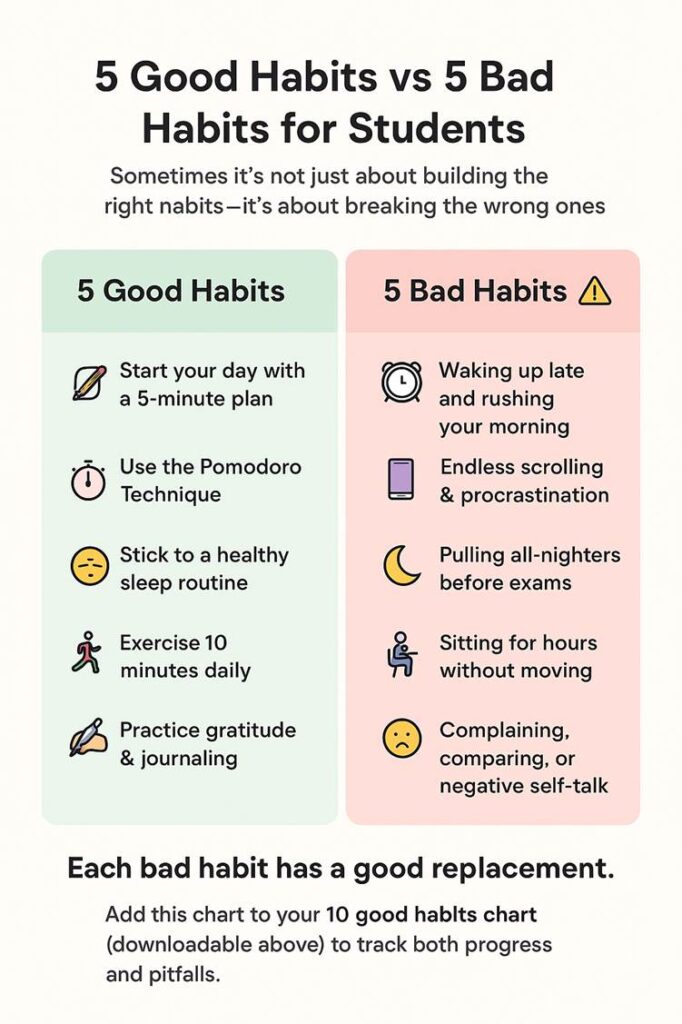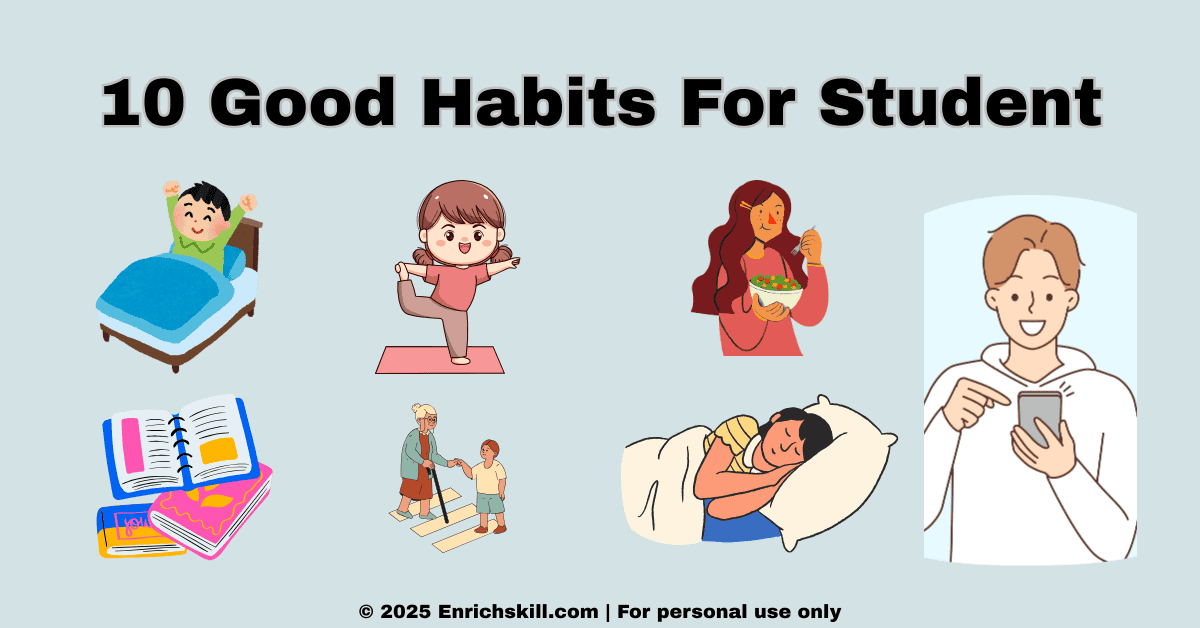It’s 2025, and being a student means balancing more than just textbooks. Online classes, AI-powered study tools, and constant social media notifications make it harder than ever to stay disciplined. But here’s the truth: success isn’t built overnight—it’s shaped by consistent daily routines and small but powerful habits.
That’s why in this guide, we’ll explore 10 good habits for students that can transform the way you learn, stay focused, and grow. From managing your time wisely to maintaining healthy study practices, these habits are practical, science-backed, and easy to follow.
Think of this article as your good habits chart for success in 2025. By the end, you’ll not only know 10 good habits in English clearly explained, but also how to put them into action daily. Ready to start building habits that last a lifetime? Let’s dive in.
Table of Contents
ToggleWhy Good Habits Matter for Students in 2025
In 2025, students face more challenges than ever before — endless distractions from social media, rising academic pressure, and the stress of balancing studies with personal growth. This is why building good habits for students is more than discipline; it’s about creating a lifestyle that supports focus, learning, and overall well-being.
Research proves that success doesn’t come from cramming the night before exams but from 10 good habits practiced consistently. A simple 10 good habits chart or even a daily checklist can guide students to stay on track. Whether you’re writing down goals or trying to write 10 good habits for self-improvement, small steps lead to big achievements.
That’s why, for long-term success, 10 good habits for students in English can be the foundation of thriving in academics and life.
10 Good Habits for Students |Daily Routine for Success
1. Start Your Day with a 5-Minute Plan
Most students wake up and rush straight into their day — checking their phone, hurrying to class, or cramming last-minute notes. The result? Stress and wasted time. Instead, begin your mornings with a simple 5-minute plan.
Take a notebook (or even a sticky note) and write down:
- 3 things you must complete today (study, assignments, revision).
- 1 healthy habit (like reading, exercise, or meditation).
- 1 personal goal (such as connecting with a friend or practicing gratitude).
This tiny practice sets your daily structure and builds orderliness in your routine. Over time, these notes act like your personal 10 good habits chart, reminding you that success comes from small, consistent actions — not cramming the night before.
👉 Pro tip: Do this planning before touching your phone. The clarity it gives is worth more than 30 minutes of scrolling.
2. Stay Focused with the Pomodoro Technique | Good Habit for Students
Distractions like Instagram reels and constant notifications make it harder than ever for students to stay focused in 2025. That’s where the Pomodoro Technique—a simple time-blocking strategy—can become one of the 10 good habits for students to master.
Here’s how it works: you study with full concentration for 25 minutes, then take a 5-minute break. After four such cycles, reward yourself with a longer 15–20 minute break. Science shows that short bursts of deep focus help your brain retain information better than long, unfocused study sessions.
For example, if you’re preparing for math, completing just two Pomodoro cycles a day can help you cover formulas without feeling overwhelmed. Out of the 10 good habits for students in English, staying disciplined with the Pomodoro method is a habit that consistently improves focus and productivity.
It’s not just about studying harder—it’s about studying smarter and sustainably.
3. Master Spaced Repetition & Active Recall | Smart Study Habit for Students
One of the smartest study strategies to include in your good habits for students is combining spaced repetition with active recall. Instead of rereading notes or cramming, you review at increasing intervals (Day 1, 3, 7) and test yourself each time. This trains your brain to retrieve information—faster, stronger, and for longer.
To make it stick, add this to a simple 10 good habits chart or planner:
Create quick flashcards after class.
Schedule mini self-tests on Day 1, Day 3, Day 7.
End the week with a 10-minute recap quiz.
If you were to write 10 good habits that actually move grades, this combo would be near the top. Even starting with 5 good habits—Pomodoro, spaced repetition, active recall, weekly review, and distraction blocking—builds momentum without burnout.
Pro tip: Use digital flashcards and set reminders so the spacing happens automatically.
4. The ABC Method: Simple Student Hack to Manage Time & Stress
Ever felt overwhelmed by a mountain of homework, exams, and projects? You’re not alone. One of the smartest good habits for students is learning how to prioritize tasks instead of just working harder. That’s where the ABC Method comes in — a simple but powerful system used by productivity experts (and now, successful students worldwide).
Here’s how it works:
- A Tasks → Crucial and urgent (e.g., tomorrow’s test revision).
- B Tasks → Important but less urgent (e.g., starting your long essay due next week).
- C Tasks → Nice to do, but not essential (e.g., reorganizing your notes).
By labeling tasks A, B, or C, you’ll instantly know where your energy should go. Instead of wasting hours stressing, you’re actually saving time and reducing burnout.
Example: If you’ve got three subjects to study, instead of bouncing randomly between them, start with the “A” subject (exam tomorrow), then move to the “B” subject, and only do “C” tasks if time allows.
📌Why it’s a top habit for students in 2025:
With constant distractions from social media, the ABC Method acts like a mental filter. It gives you focus, keeps stress low, and ensures that you finish the most impactful work first. This habit alone can set apart average students from high achievers.
5. Why a Digital Curfew is a Good Habit for Students to Sleep Better & Study Smarter
Picture this: it’s 11 p.m., you’re deep in a TikTok scroll, swearing “just one more video.” Suddenly, it’s 1 a.m., and you’re dragging through class the next day, barely able to focus. Sound familiar? Late-night scrolling isn’t just stealing your time—it’s wrecking your sleep and grades. That’s why a digital curfew is one of the top good habits for students in 2025.
By setting a strict cutoff time for screens (like 9 p.m. or an hour before bed), you give your brain a chance to unwind. Science proves it: blue light from devices blocks melatonin, making it harder to fall asleep. A curfew fixes that, boosting your focus, memory, and energy for studying.
Here’s how to nail it:
Pick a cutoff time: Work backward from your wake-up time (e.g., 10 p.m. for 6 a.m.).
Swap scrolling for calm: Try reading, stretching, or jotting down tomorrow’s tasks.
Tech-proof your night: Use app blockers or charge your phone outside your room.
This isn’t about ditching fun—it’s about owning your energy so every study session counts. Add this to your 10 good habits chart for daily tracking, and you’ll see results fast. Among 5 good habits to start today, this one’s a game-changer for sleep and productivity.
👉 Pro tip: Set a nightly alarm for your curfew time. Stick to it for a week, and you’ll wake up sharper, ready to crush it. If you had to write 10 good habits, this would be near the top.
6. Move for 10 Minutes: The Brain-Boosting Good Habit for Students
Ever feel your brain hitting “pause” during long study sessions? That’s your body begging to move. Staying active—even for 10 minutes—is one of the healthy habits for students that directly fuels sharper focus, stronger memory, and less stress. Science backs it: exercise triggers BDNF (a brain protein) that helps you learn faster.
✅ Easy ways to add movement to your day:
- Take a brisk 10-minute walk between classes.
- Do quick stretches or push-ups during study breaks.
- Listen to your lecture notes while jogging.
It’s not about gym memberships—it’s about consistency. Add this to your 10 good habits chart, and you’ll see the difference in energy and grades.
👉 Pro tip: Treat movement like a study break, not a chore. Set a 10-minute timer and reset your brain before your next session.
7. Master Your Sleep Routine | The Secret Good Habit for Students in 2025
Pulled an all-nighter only to blank out in the exam hall? That’s the price of poor sleep. A healthy sleep routine is more than rest—it’s one of the healthy habits for students that unlocks focus, memory, and productivity in 2025. Science shows that deep sleep consolidates what you study, turning late-night cramming into long-term knowledge.
✅ Quick ways to fix your sleep routine:
- Set a bedtime like a class you can’t skip. Aim for 7–8 hours.
- Wind down 30 minutes before bed. Dim lights, read, or journal.
- Pair it with your digital curfew. Say no to late-night scrolling.
This isn’t just about feeling fresh—it’s about smarter studying, sharper recall, and less stress. Add it to your 10 good habits chart and track your consistency.
👉 Pro tip: Set a “bedtime alarm.” Treat it as seriously as your morning one. Stick with it for 7 days, and you’ll wake up focused, not foggy
8. Gratitude Journaling: The Good Habit Every Student Needs in 2025
Ever feel buried under exam stress or social pressure? Gratitude or journaling can be your reset button. As one of the 10 good habits for students, this simple practice reduces stress, boosts focus and rewires your brain for positivity. Research shows that writing what you’re thankful for triggers serotonin—the “happy hormone”—making you calmer and more productive.
✅ How to make it work daily:
- Spend 5 minutes before bed jotting 3 things you’re grateful for.
- Keep it simple: use a notebook or an app—whichever feels natural.
- Reflect on wins: write about small successes (like acing a quiz) to build confidence.
It’s a micro-habit with a macro impact. Add it to your 10 good habits chart to track progress and stay motivated
👉 Pro tip: Start with “Today, I’m thankful for…” and let it flow. In a week, you’ll notice less stress and sharper focus.
9. Deep Work Over Multitasking: The Student Habit That Boosts Grades in 2025
Multitasking feels productive—but it actually kills performance. Studies show it can reduce efficiency by up to 40% and overload your brain. That’s why deep work—focusing on one task at a time—is a good habit for students who want sharper focus, faster learning, and better grades in 2025.
✅ How to practice deep work daily:
- Pick one task only: Whether homework or revision, give it your full attention.
- Cut distractions: Silence notifications, close unused tabs, and use a 25–50 min focus timer.
- Schedule focus blocks: Start with 1 hour daily, then increase as it gets easier.
⚡ Benefit recap: Better concentration, higher-quality work, and less stress compared to multitasking.
👉 Pro tip: Try apps like Forest or Focus To-Do—they gamify focus, making deep work fun and trackable.
10. Why Reflecting & Planning Before Sleep Is a Top Good Habit for Students
Before you sleep, your brain is still processing the day. Use that moment wisely—because reflection and planning are two good habits for students that multiply focus and reduce stress. Research shows nightly reflection lowers anxiety, while planning tomorrow boosts productivity and confidence.
✅ Here’s how to make it work:
- Reflect: Write down one thing you achieved today (big or small). This builds momentum.
- Plan ahead: List 2–3 key tasks for tomorrow—so you wake up with clarity.
- Keep it short & simple: 5–10 minutes is enough; consistency matters more than length.
⚡ Why it works: Ending the day with reflection clears mental clutter, while pre-planning helps you wake up ready to execute. It’s not just another tip—it’s a student success system.
👉 Pro tip: Use a “reflection journal” or even a simple notes app. Over time, you’ll see patterns in what works best for your success—and that’s how you stay ahead of 95% of students.
The Ultimate Good Habits Chart for Students to Stay Organized

Struggling to stick to all 10 good habits for students every day? You’re not alone. The trick is not just knowing the habits—it’s tracking them daily. That’s where a Good Habits Chart comes in.
This one-page chart keeps you consistent, motivated, and stress-free. Research shows that students who track habits are 40% more likely to stick to them.
Here’s a sample you can use right away 👇
✅ 10 Good Habits Chart for Students
| No | Habit | Description | ✅ Daily Check |
| 1 | Wake Up Early | Start the day fresh with enough time for studies and school. | ☐ |
| 2 | Morning Exercise | Do 10–15 minutes of stretching or walking to stay active. | ☐ |
| 3 | Eat Healthy Breakfast | Never skip breakfast; include fruits or milk for energy. | ☐ |
| 4 | Stay Organized | Keep books, bags, and stationery neat and ready for school. | ☐ |
| 5 | Finish Homework on Time | Complete assignments daily instead of rushing last minute. | ☐ |
| 6 | Read Daily | Spend at least 20 minutes reading (school books or other). | ☐ |
| 7 | Limit Screen Time | Reduce mobile/TV use, focus more on studies & hobbies. | ☐ |
| 8 | Practice Good Manners | Be polite, respectful, and helpful to teachers & friends. | ☐ |
| 9 | Revise Before Sleep | Quickly revise what you studied during the day. | ☐ |
| 10 | Sleep Early | Get 7–8 hours of proper sleep for better focus. | ☐ |
👉 Want the ready-to-use version?
🎁 Download the Free 10 Good Habits Chart for Students
📌 Pro Tip: Pin your printed chart near your study desk or use the digital version on your phone. Checking off habits daily gives you a “mini win” that compounds into big results.
Bonus: 5 Good Habits vs 5 Bad Habits for Students
Sometimes it’s not just about building the right habits—it’s about breaking the wrong ones. To truly succeed, students must replace bad habits with good ones. Here’s a quick comparison chart:
| 🚀 5 Good Habits (Success Boosters) | ⚠️ 5 Bad Habits (Productivity Killers) |
| tart your day with a 5-minute plan 📝 | Waking up late and rushing your morning ⏰ |
| Use the Pomodoro Technique ⏳ | Endless scrolling & procrastination 📱 |
| Stick to a healthy sleep routine 😴 | Pulling all-nighters before exams 🌙 |
| Exercise 10 minutes daily 🏃 | Sitting for hours without moving 🪑 |
| Practice gratitude & journaling ✍️ | Complaining, comparing, or negative self-talk 😞 |
👉 Notice something? Each bad habit has a good replacement. If you drop even one bad habit and swap it for its positive twin, your student life improves instantly.

📌 Pro Tip: Add this chart to your 10 good habits chart (downloadable above) to track both progress and pitfalls.
How to Build and Stick to These 10 Good Habits for Students in 2025
Reading about the 10 good habits for students is the easy part—living them daily is where the magic happens. But here’s the truth: habits stick only when you make them simple, visible, and rewarding. In 2025’s fast-paced world, where distractions are just one tap away, you need a system that keeps you consistent.
Here’s your student-friendly blueprint
1. Start Small
Don’t try to adopt all 10 good habits at once. Begin with one or two (like the Pomodoro technique or a sleep routine) and master them first. Success compounds.
2. Use Habit Stacking
Link a new habit with something you already do. Example: After brushing teeth at night → write in your gratitude journal. This makes habits automatic.
3. Track Progress (Use the Chart!)
Print or download the 10 Good Habits Chart for Students and tick off daily wins. Tracking builds momentum and keeps you accountable.
4. Reward Yourself
Celebrate small wins. Finished a week of consistent study sessions? Treat yourself to a movie night or favorite snack. Rewards train your brain to crave good habits.
5. Stay Flexible, Not Perfect
Missed a day? No problem. Consistency matters more than perfection. Reset and get back on track tomorrow—no guilt trips.
📥 Download your FREE “10 Good Habits Chart for Students” [here]
Conclusion: Turn These 10 Good Habits into Your Superpower
Success in school (and life) isn’t about luck—it’s about habits. By building these 10 good habits for students, you’re not just preparing for exams in 2025, you’re creating a lifelong system for focus, productivity, and confidence. From managing time with the Pomodoro Technique to staying active, journaling, and sticking to a healthy sleep routine, every small step compounds into massive results.
Remember: habits don’t work unless you do. Start with one, track it on your Good Habits Chart, and build momentum. A year from now, you won’t just be a better student—you’ll be unstoppable. 🚀
👉 Now it’s your turn:
- Which of these good habits for students will you start today?
- Comment below—I’d love to hear your plan!
- And don’t forget to download your free “10 Good Habits Chart for Students” to track progress and stay accountable.
🎁 Free Resource for You
Want to stay consistent? Download your Free 10 Good Habits Chart for Students (PDF/Printable) and start tracking your daily wins today!
👉 [Download the Habits Chart Here]
Pin it on your wall, or use it digitally—either way, this chart will keep you accountable and motivated.
FAQs on Good Habits for Students in 2025
Q1. What are the 10 good habits for students?
The 10 good habits include: planning your day, using the Pomodoro Technique, practicing spaced repetition, applying the ABC method, setting a digital curfew, staying active, maintaining a healthy sleep routine, journaling, focusing on deep work, and reflecting before sleep.
Q2. Why are good habits important for students?
Good habits build consistency, reduce stress, and improve focus—helping students score better grades and stay balanced in daily life.
Q3. Which 5 good habits should every student start with?
Use a 10 good habits chart (downloadable above), set reminders, and start small. Consistency matters more than perfection.


1 thought on “10 Good Habits for Students to Succeed in 2025 | Daily Routine for Success”